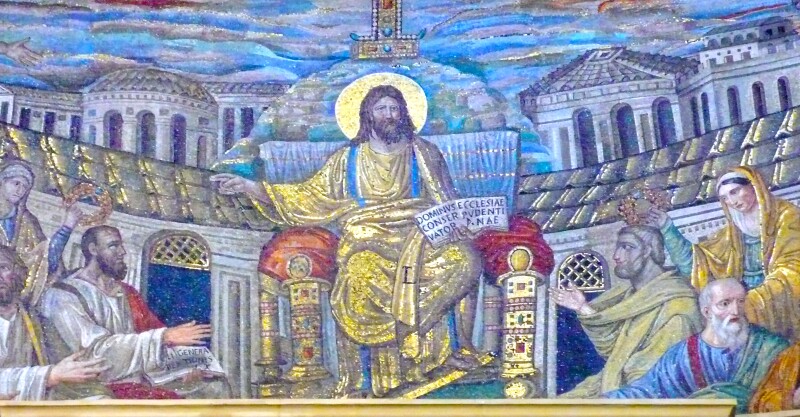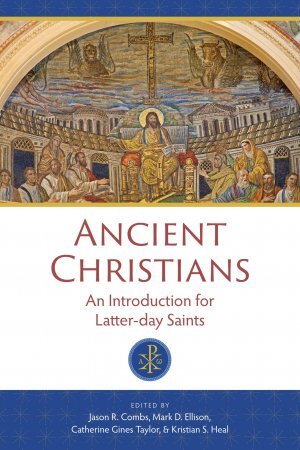As we prepare to read the New Testament for Come, Follow Me in 2023, there are many ways that we can enhance our study. The Lord has instructed us to seek “out of the best books words of wisdom” (Doctrine and Covenants 88:118), and Brigham Young taught that we should “gather up all the truths in the world pertaining to life and salvation,” even “to the Gospel we preach.”
One way to follow this counsel is by turning our hearts to our spiritual ancestors, our ancient Christian fathers and mothers who lived in the centuries after the mortal ministry of Jesus and his Apostles. Here are five things that Latter-day Saints should know about these ancient Christians.
1. They taught that becoming like God begins in this life.
As early as AD 180, Irenaeus of Lyons taught that Christ became “what we are, that He might bring us to be even what He is Himself.”1 This idea was reaffirmed by other ancient Christians. For instance, Athanasius of Alexandria (ca. AD 296–373) wrote that Jesus Christ, the Word of God, “assumed humanity”—that is, he took on all that it means to be human—“that we might become God.”2
Ancient Christians had different understandings from Latter-day Saints regarding what it meant to become like God. Professor Daniel Becerra explains: “Irenaeus and Athanasius understood God (as Creator) and humans (as creations) as different species, so to speak, rather than the same species albeit at different points of development.”3 Despite this important distinction, Latter-day Saints can still find this ancient Christian teaching insightful and edifying.
For instance, some ancient Christians saw mortal life as an opportunity to grow into the likeness of God by developing Christlike attributes. Origen of Alexandria (ca. AD 185–254) read in Genesis 1:26, where God says, “Let us make man in our image, after our likeness,” and noticed the next verse says only that God creates human beings in his image (Genesis 1:27). He interpreted this as follows:
Humankind received the honor of God’s image in their first creation; whereas the perfection of God’s likeness was reserved for them at the consummation. The purpose of this was that humans should acquire it for themselves by their own earnest efforts to imitate God, so that while the possibility of attaining perfection was given to them in the beginning through the honor of the “image,” they should in the end through the accomplishment of these works obtain for themselves the perfect “likeness.”4
For Origen, human creation does not end in Eden. Rather, we become like God as we develop Christlike character throughout our lives and into eternity. In Eden we are given the potential to progress when we were made in the image of God, in heaven that potential is fully realized as we obtain the likeness of God.
2. They believed the Father, Son, and Holy Ghost are distinct personages.
The word Trinity (Latin, trinitas) was first used by a Christian named Tertullian around AD 200.5 He used the term to encapsulate his belief that the Father and the Son were distinct persons who were one in other ways. Latter-day Saints have sometimes assumed that Christians who accept the Nicene Creed (AD 325) believe that God the Father, the Son, and the Holy Ghost are one person. After all, the creed states that God the Father and the Son are homoousios—a Greek word sometimes translated as “same substance” or “one being.” Yet this term was clarified by the Council of Chalcedon (AD 451) in the following way: Jesus Christ is “one substance [homoousios] with the Father as regards his divinity, and … one substance [homoousios] with us as regards his humanity.”6
In other words, Jesus is “one substance” with the Father just as he is “one substance” with us humans—and clearly we are not the same person as Jesus. For ancient Christians, the terms “being” and “person” meant different things. Christians used the term “being” to describe the oneness of God, the divine nature of God the Father, the Son, and the Holy Ghost. These same Christians also affirmed that the Father, the Son, and the Holy Ghost are three distinct “persons.”
Elder Jeffrey R. Holland taught, “I think I am safe in saying that part of the reason we are so misunderstood by others in the Christian tradition is because in stressing the individual personages of the Godhead, we have not followed that up often enough by both conceding and insisting upon Their unity in virtually every other imaginable way. For this we have reaped needless criticism, and we have made our LDS position harder to be understood than it needs to be.” Understanding how ancient Christians described their beliefs about the nature of God can help us appreciate the beliefs of others and more accurately understand and explain our own beliefs.
3. They found scriptural symbolism in their sacred ordinances.
Latter-day Saints can better understand our modern forms of worship, including temple ordinances, by learning how ancient Christians worshipped. For instance, by the fourth century, baptism developed into a richly symbolic, multistep ceremony. This ancient baptismal service began in private. Often the candidate would be anointed with oil after she had renounced Satan and the evils of this world. Then she entered the font, perhaps kneeling in the water.
As she confessed faith in God the Father, she would bend forward and be immersed in the water by the bishop. Then she confessed faith in the Son, Jesus Christ, and again was immersed in the water. She was immersed a third time after confessing faith in the Holy Ghost. This newly baptized woman next “received the laying on of hands with another anointing of oil” and “was clothed in a white robe.”7 She could now join the congregation of those already baptized, who were waiting to celebrate with the newest Christians by receiving the Eucharist—what we call the sacrament.
As Latter-day Saints, we can see similar symbolism in some of our own sacred ordinances. Professor Mark Ellison explains:
The white robe worn by the newly baptized alluded to Paul’s teaching, “All of you who were baptized into Christ have clothed yourselves with Christ” (Galatians 3:27 NASB). … The symbol of the robe developed particular richness in the Syriac tradition of a “Robe of Glory” that Adam and Eve had originally worn in Eden but had lost: “At his or her baptism, the individual Christian, in ‘putting on Christ,’ puts on the Robe of Glory, thus … at the Resurrection of the Dead, the just will in all reality reenter the celestial paradise, clothed in their Robes of Glory.”8
The ancient Christian symbolism of the white robe will likely resonate with any Latter-day Saint who participates in our baptismal services or who worships in our sacred temples today.
4. They powerfully taught about the Atonement of Jesus Christ.
When the Apostle Paul taught about the Atonement of Jesus Christ, he would often draw on metaphorical language that had meanings outside a Christian context. The word “grace,” for instance, was used to describe relationships between Roman patrons and their clients. The term “justification” was used in legal settings to describe a proper relationship to law. And when the earliest Christians first heard the word “atonement,” they would have thought of animal sacrifices offered by priests at the temple. Paul used each of these concepts to help his readers understand better Jesus Christ’s great work of salvation.
After the first century, other Christians continued to reflect on these metaphors and on all that scripture taught about the Atonement of Jesus Christ. Metaphors developed into different models that sought to explain (1) the dilemma that Christ had come to resolve and (2) precisely how Jesus Christ resolved that dilemma. For instance, Professor Cecilia M. Peek has shown that the dilemma for some ancient Christians was that humans were lost without a guide, so Jesus came to show us the way.9
Irenaeus (ca. AD 180) wrote: “We could have learned in no other way than by seeing our Teacher and hearing His voice with our own ears, that, having become imitators of His works as well as doers of His words, we may have communion with Him.”10
Ancient Christians acknowledged that no single model could fully explain all that Jesus Christ had accomplished for us. Modern Latter-day Saint leaders have echoed that sentiment, describing the nature and effects of Christ’s Atonement as lying “beyond the knowledge and comprehension of mortal man.” President Dallin H. Oaks taught: “The magnificent and incomprehensible effect of the Atonement of Jesus Christ is based on God’s love for each of us. … His plan motivated by love must be received with love.” This beautiful and profound teaching echoes the words of Clement of Alexandria (died AD 215):
God himself is love, and for the sake of this love, he made himself known. And while the unutterable nature of God is as a Father, his sympathy with us is as a Mother. … For this [the Son] came down, for this he assumed human nature, for this he willingly endured the sufferings of humanity, that by being reduced to the measure of our weakness, he might raise us to the measure of his power. And just before he poured out his offering, when he gave himself as a ransom, he left us a new testament: ‘I give you my love’ (John 13:34; 14:27). What is the nature and extent of this love? For each of us he laid down his life, the life which was worth the whole universe, and he requires in return that we should do the same for each other.11
5. We may not always agree with ancient Christians, but we can still learn from them.
Latter-day Saints who seek to understand our ancient Christian ancestors will likely not agree with everything we find in their writings or view in the art and architecture they left behind. Although many of our core beliefs are the same, ancient Christians who lived in the centuries after Jesus’s Apostles believed and practiced some things that differ from what has been revealed to the Latter-day Saints.
Of course, we should expect to encounter some differences because God speaks to different peoples “according to their language, unto their understanding” (see 2 Nephi 31:3; see also Doctrine and Covenants 1:24). Keeping this in mind, Latter-day Saints can benefit from studying both similarities and differences in a spirit of charity. In so doing, we follow Christ’s admonition: “As ye would that men should do to you, do ye also to them likewise” (Luke 6:31).
As we explore the world of ancient Christianity in a spirit of humility and love, we will discover new richness and new understanding about our own beliefs and practices, and we will come to understand better many of our fellow Christians today. I believe that turning our hearts to our ancient Christian fathers and mothers is part of what President Brigham Young had in mind when he encouraged us to seek truth among other churches and gather it to Zion.
You can learn more about our ancient Christian ancestors in the new book Ancient Christians: An Introduction for Latter-day Saints, published by BYU Maxwell Institute.
Notes
- Irenaeus, Against Heresies 5, preface (ANF 1:526).
- Athanasius, On the Incarnation 54 (NPNF2 4:65).
- Daniel Becerra, “Becoming Like God: Incarnation, Moral Formation, and Eternal Progression,” in Ancient Christians: An Introduction for Latter-day Saints, ed. Jason R. Combs, Mark D. Ellison, Catherine Gines Taylor, and Kristian S. Heal (Provo, UT: Neal A. Maxwell Institute for Religious Scholarship, 2022), 377; box 10.3.
- Origen of Alexandria, On First Principles 3.6.1; in On First Principles, trans. G. W. Butterworth (Notre Dame: Ave Maria Press, 2013), 321.
- For more on the meaning of “Trinity,” see Jason R. Combs, “The Nature of God: Father, Son, and Holy Ghost,” in Ancient Christians, 290–326.
- For the Chalcedonian Definition, see Combs, “Nature of God,” 310, box 8.9; compare John 17:21.
- See the summary provided by Mark D. Ellison, “Connecting with Christ: Rituals and Worship” in Ancient Christians, 214.
- Ellison, “Connecting with Christ,” 214–16; quoting Sebastian Brock, St Ephrem the Syrian: Hymns on Paradise (Crestwood, NY: St Vladimir’s Seminary Press, 1990), 67.
- Cecilia M. Peek, “Receiving Christ: Atonement, Grace, and Eternal Salvation,” in Ancient Christians, 343.
- Irenaeus, Against Heresies 5.1.1 (ANF 1:526); as quoted by Peek, “Receiving Christ,” 343.
- Clement of Alexandria, The Rich Man’s Salvation 37 in Clement of Alexandria: The Exhortation to the Greeks, ed. G. W. Butterworth, Loeb Classical Library 92 (Cambridge, MA: Harvard University Press, 1960), 346.



